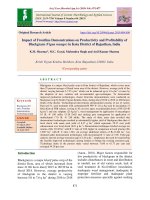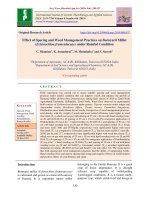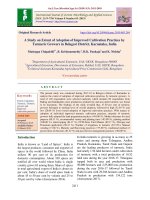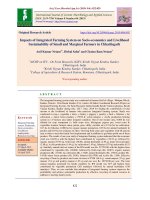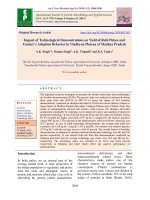Impact of agroforestry practices on livelihood improvement of farmers in Ichak block of Hazaribagh district, Jharkhand, India
Bạn đang xem bản rút gọn của tài liệu. Xem và tải ngay bản đầy đủ của tài liệu tại đây (280.88 KB, 11 trang )
Int.J.Curr.Microbiol.App.Sci (2019) 8(1): 702-712
International Journal of Current Microbiology and Applied Sciences
ISSN: 2319-7706 Volume 8 Number 01 (2019)
Journal homepage:
Original Research Article
/>
Impact of Agroforestry Practices on Livelihood Improvement of Farmers in
Ichak Block of Hazaribagh District, Jharkhand, India
Rajiv Kumar Mahato, R.B. Sah, P.R. Oraon* and Bijay Kumar Singh
Department of Silviculture and Agroforestry, Faculty of Forestry, Birsa Agricultural
University, Ranchi, Jharkhand, India
*Corresponding author
ABSTRACT
Keywords
Land holding,
Silvipasture, Bund
plantation, Impact,
Livelihood
Article Info
Accepted:
07 December 2018
Available Online:
10 January 2019
In Ichak block of Hazaribagh district farmers are adopting different land use practices (viz.
agriculture and agroforestry systems) on their land. The present investigation was
conducted to identify the existing agroforestry practices and livelihood status of farmers.
For conducting the study a total of 160 households from four panchayats and eight villages
(two villages from each panchayat) were selected through multistage random sampling.
Data were collected through survey and by interview of head of the household on pretested and pre-structured questionnaire as well as group discussions with villagers. The
results revealed that majority of households (98.12%) were headed by male member
having age between 40-60 years. All the respondents practice different type of agroforestry
practices on their farm. About 80 percent household practices agroforestry on 0.5 to 1.0
acre size of farm land. The prevalent existing agroforestry practices in the area were found
to be Homestead (84.38%), Trees on Field Bunds (8.12%), and Silvipasture (7.50%). 25.00
% household had maximum monthly income ranged between Rs. 9001-11000 followed by
16.87 % of more than Rs. 11000 and Rs.1001-3000. Therefore, the rural people should
make some strategy for the implementation of agroforestry model with suitable
combination of trees and field crops.
Introduction
Agroforestry have two main objectives: first,
to increase the efficiency of the use of rural
resources by reducing or eliminating
ecologically destructive land-use practices and
by introducing new or improved agroforestry
enterprises in order to produce sustainable
increases in incomes and living standards, and
second, to provide for social equity (Mercer,
1993). Agroforestry is combination of trees
and shrubs with crops and/or livestock which
can result in elevated income of rural people
and forest production along with conserving
natural resources (Molua, 2005). Agroforestry
can act as a solution to address low land
productivity and soil erosion. Economic
benefits and helping farmers to meet their
food requirements are of the most important
and positive social and economic aspects of
this intensive land management system
(Saxena, 1994; Thapa and Weber, 1994).
Rural
families’
livelihood
strategies
encompass
multiple
objectives
in
702
Int.J.Curr.Microbiol.App.Sci (2019) 8(1): 702-712
maximization of land utilization, like secure
provision of food and subsistence goods, cash
for purchase of goods and services and
savings for future needs (Scher, 1995).
Households choose a mix of activities that
contributes most towards their multiple
objectives and yields greatest utility.
Agroforestry is as old as agriculture itself.
Many of the anecdotal agroforestry practices,
which are time tested and evolved through
traditional indigenous knowledge, are still
being followed in different agro-ecological
zones. The traditional knowledge and the
underlying ecological principles concerning
indigenous agroforestry systems around the
world have been successfully used in
designing the improved systems. The global
community has to recognize the potential
benefit of many underexploited systems to
address the most intractable land-management
problems, such as food and nutrient security,
climate change mitigation and adaptation,
biodiversity conservation, and rehabilitation of
degraded ecosystems. As we move forward to
vigorously exploit these potential benefits, we
will witness the involvement of agroforestry
and its progress for solving these problems
and be able to ensure food and environmental
security at global level (Dagar, 2016).
Agroforestry, which is the inclusion of woody
perennials in farming systems, has been
practiced as traditional land use and livelihood
option in Jharkhand state of India since time
immemorial. The Jharkhand state is well
known for its vast coal reserves and forest
cover, which also includes the traditional
agroforestry systems. The state is having 4.21
per cent of total geographical area under tree
green cover in agroforestry (FSI, 2011).
Materials and Methods
The experiment was conducted at Ichak block
of Hazaribagh district of Jharkhand which is
lies between 85°22'E longitude and 23°21'N
latitude in agro climatic zone IV. The
selection criteria for study of villages were
their geographical distribution under districts
and presence of agroforestry in that area using
random sampling. The study was observed
through household survey with the help of
questionnaire, house hold interviews, focus
group discussions and participatory rural
assessment using random sampling technique.
Data collection on socio-economic status, land
use
characteristics,
resources/supporting
services, general awareness and participation
with respect to various agroforestry activities.
Thus, 160 random selected households in the
villages were surveyed to determine gender,
cast, literacy, average land holding size, area
under different land uses, trees, shrubs and
crops used for various purposes and income
generation.
Results and Discussion
Details of the household
The details of the household study area are
shown in Table 1. Perusal of the table
indicated that 98.12 % male and 1.88 % of
female respondents was found in area.
According to (Rocheleau, 1985 and Thakur et
al., 2018) family composition affects both
household and individual needs and priorities
for agroforestry interventions. Kamanaga
(1998) suggested that gender of household’s
headship may influence the accessibility to
farm resources. The maximum number of
household found in 40-50 age profile 39.38 %
followed by 50-60 age class 35.00 % and
minimum were 20-30 age class 1.25 %.
Varied relationship between age of the farmers
and innovation adoptions has been reported by
(Rogers and Svenning 1969, Glover et al.,
2013) commented that younger farmers accept
change and adopt innovations more readily
compared to older farmers. The caste of the
study area was maximum found in OBC 88.12
% followed by SC 10.00 % and minimum in
GEN 0.62 %. Maximum 31.88 % of Literacy
703
Int.J.Curr.Microbiol.App.Sci (2019) 8(1): 702-712
found in high school followed by no school
22.50 % and minimum were found in
Intermediate13.75 %. Farmers with lower
education levels are considered to be low
adopters and risk averse. (Rogers and
Svenning, 1969; Himshikha, 2016) asserted
that the education level decreases from
innovators to late adopters, and persons with a
higher level of education are supposedly more
capable of understanding the innovation.
Korsching et al., (1983) showed that education
relates directly to innovation. The higher the
level of education the more likely landowners
are to be interested in adopting new practices
like agroforestry. Older farmers are viewed as
less flexible, more risk averse, and less willing
to engage in innovative farm technology
(Thacher et al., 1997). The farm experience
and education (both formal education and
informal training) of the farmer are important
characteristics that influence decisions made
in farm tree growing (Adesina and Chianu,
2002). Aturamu and Daramola (2003) reported
that adoption of agroforestry increased with
the rise in level of farmer education. Dorr
(2006) found impact of education level
significant in silvopasture and not significant
in windbreaks, alley cropping, riparian buffers
and forest farming. Maximum 98.12 % of
household found in Hindu community
followed by 1.88 % of Muslim community
(Himshikha, 2016; Thakur et al., 2018). In
primary occupation maximum 88.75 % of
households doing farming work followed by
6.25 % doing private job and minimum were
0.62 % doing construction worker.
In
secondary occupation maximum 31.88 % of
households doing stone crushing followed by
28.75 % doing agricultural labour and
minimum were 1.88 % doing Poultry.
According to Kumar et al., (2018) almost all
households (99.17%) were engaged in farming
as a primary occupation and 38.33% as
agricultural labour and 26.67% in construction
works and only 14.17% were engaged in
private job in Gumla district of Jharkhand.
Total land holding details of households (in
ha)
Total land holding of the households (in ha) is
shown in Table 2. Perusal of data showed that
maximum 25% of people had 2.1 – 2.5 ha
followed by 23.12% of people had 1.51 -2.0,
ha and minimum 4.37% had 3.1-3.50 ha land.
Nahar (2009) studied on agroforestry and
observed that the average size of the
homestead in the study area was 0.12 ha
which increased with the increased of farm
size. The trade-off between agricultural
production and tree growth is an important
factor in the farmers’ allocation of family land
and labour. The positive effect of landholding
size on farm level tree growing has been
reported by Salam et al., (2000) in Bangladesh
and Dwivedi et al., (2009) in India. They
argued that when land becomes scarce, the
overriding need to produce food takes
precedence over the long-term value of trees
thereby implying a decreasing likelihood of
growing trees with decreasing size of
landholding. The present finding is in line
with the findings of (Kumar et al., 2017;
Singh and Oraon, 2017; Thakur et al., 2018;
Lakra et al., 2018).
Land use practices
Different type of land use practices doing in
the study area like agroforestry, bamboo,
horticulture, agriculture is shown in Table 3.
The data indicated that maximum 80 % of
households doing agroforestry in 0.5 to 1 acre
land where as 77.50 %, of household grow
bamboo in less than 0.5 acre land. The
horticulture crop grows maximum 68.75 %
households in the area of 0.5 -1.0 acre lands
where as 40 % of household doing agriculture
1.1-2.0 acre lands. The similar finding is in the
studies of Kumar et al., (2017) and Thakur et
al., (2018) conducted in Gumla, and Giridih
district of Jharkhand.
704
Int.J.Curr.Microbiol.App.Sci (2019) 8(1): 702-712
Existing agroforestry modules in the village
The existing modules in the village are shown
in Table 4. The data showed that silvi-pasture
system, bund plantation and home garden
agroforestry systems was found in the study
area. The data showed that 84.37%
respondents were practicing home gardening
system followed by 8.12% trees on field bunds
and 7.50% on silvipasture system. Dagar
(2016) reviewed research developments in
agroforestry during past four decades. He
stated that the tress that are grown in
agricultural fields or on fields bunds are also
often and usually grown on farm boundaries.
Pathak et al., (2014) and Korwar et al., (2014)
have also dealt in detail the plantations on
bunds for Rain-fed areas and Indo-gigantic
plains of India.
Total number of livestock
Perusal of data indicated that maximum 90.62
% of households have bullock followed by
78.12 % cow and minimum were 0.62 % of
duck and improved breed Table 5. Livestock
contribute significantly to the household
income of small-scale homegardens in many
developing countries, while fulfilling many
social and cultural needs (Wilson, 1995).
Livestock utility
The livestock utility such as manure, draft
power, milk and meat are shown in Table 6.
Perusal of data showed that 100%
respondent’s uses manure and draft power
followed by 88.12 % of milk and minimum
were 21.88 % of meat.
Monthly income from livestock is shown in
Table 6. Perusal of table showed that the
maximum monthly income was found
maximum in 30.62 % of 501-1000 followed
by 20.62 % of <100 and minimum were 1.25
% of 2501-3000. In some of the very small
gardens, where land is a constraint to
production, livestock are sometimes the main
income generators, serving as cash buffers and
capital reserves (Devendra and Thomas, 2002)
and also contributing to the nutrient cycling in
the system (Thorne and Tanner, 2002).
Component distribution
agroforestry system
in
different
The component distribution in different
agroforestry system and in Ichak block is
presented in Table 7. The data has indicated
that the tree species and agricultural crops
combination reflects the different in
agroforestry system. In trees on field Bunds
system the tree species were Gmelina arborea
(Gamhar),
Dalbergia
sissoo
(Sissoo),
Swietenia mahagoni (Mhagoni), Madhuka
indica (Mahua), Tectona grandis (Teak),
Syzygium
cumini
(Jamun),
Ziziphus
mauritiana (Ber), Mangifera indica (Mango)
and Artocarpus heterophyllus (Kathal) where
as agriculture species were Solanum
melongena (Brinjal), Solamum tuberosum
(Potato), Lycopersicon esculentum (Tomato),
Zingiber officinale (Ginger),
Phaseolus
vulgaris (Bean), Brassica oleracea capitata
(Cabbage), Brassica oleracea appetite
(Cauliflower), Capsicum annuum (Chilly)
Triticum aestivum (Wheat), Oryza sativa
(Paddy), Brassica nigra (Mustard) and Zea
mays (Maize). In Silvipastoral system tree
species were Dalbergia sissoo and Ziziphus
mauritiana, where as grasses species were
Cynodon dactylon and Cyperus scariosus
(Grasses). In Homegarden system tree species
were Gmelina arborea, Tectona grandis,
Mangifera indica Moringa oleifera, Psidium
guajava and Artocarpus heterophyllus where
as agriculture species were Solanum
melongena,
Solamum
tuberosum,
Lycopersicon esculentum, Brassica oleracea
appetite, Phaseolus vulgaris and Capsicum
annuum. Similarly, Hemrom and Nema (2015)
the different agroforestry system perform by
705
Int.J.Curr.Microbiol.App.Sci (2019) 8(1): 702-712
the people existing in Baster region are
agrisilviculture with combination of tree like
Shorea robusta, Tectona grandis, Acacia spp.
etc. in agrisilvopastural with combination
crop with tree like Albizia Spp., Leucaena
leucocephala, Ficus racemosa etc. In
agrihoritsilvcultural practices with many fruit
trees and multipurpose trees like Cocos
nucifera, Caraya papaya, Musa acuminate,
Mangifera indica, Anacardium ocidentale,
Embellica officinalis etc. and in homegarden
species like Dalbergia latifolia, Mangifera
indica,
Moringa
oleifera,
Leucaena
leucocephala, Artocarpus heterophyllus,
Anacardium occidentale etc. In Manipur,
under different agroforestry practices the
agriculture crops like zea mays, Cajanas
cajan, Vigna ungulcuate are grown with
fodder grasses Pemphis purpureum, Teosinte
changing etc, and the tree species are Parkia
roxburghii,
Litsea
polyantha,
Alnus
nepalensis, Albizia lebbeck, Artocarpus, Ficus
etc, (Singh et al.1996).
Table.1 Details of the Household
Details of the Household
Gender
Age Profile
Caste
Literacy
Religion
Primary occupation
Secondary occupation
Male
Female
20-30
30-40
40-50
50-60
Above 60
GEN
OBC
SC
ST
No Schooling
Elementary
High School
Intermediate
College
Hindu
Muslim
Farming
Constructionb Worker
Stone Crushing
Private Job
Government job
Agri Labour
Poultry
Non Farm
(Wage Carrier)
Stone Crushing
Private Job
706
Total
(N=120)
157
03
02
19
63
56
20
01
141
16
2
36
27
51
22
24
157
3
142
01
02
10
05
46
03
40
(%)
98.12
1.88
1.25
11.88
39.38
35.00
12.50
00.62
88.12
10.00
1.25
22.50
16.88
31.88
13.75
15.00
98.12
1.88
88.75
00.62
01.25
06.25
03.12
28.75
01.88
25.00
51
20
31.88
12.50
Int.J.Curr.Microbiol.App.Sci (2019) 8(1): 702-712
Table.2 Total Land holding details of Households (in ha)
Sl.
Total Land holding details
Total
%
No.
of Households (in ha)
N=160
>0.50
16
10.00
1
0.51 -1.0
14
08.75
2
1.1 – 1.50
28
17.50
3
1.51 -2.0
37
23.12
4
2.1- 2.50
40
25.00
5
2.51 – 3.0
09
05.62
6
3.1 – 3.50
07
04.37
7
3.51 – 4.0
09
05.62
8
Figure in parentheses indicate percentage of the respective
parameters
Table.3 Land use practices
Land use practices in (Acre)
Total
%
N=160
Agroforestry
< 0.5
0.5 – 1
32
128
20.00
80.00
124
36
77.50
22.50
31
110
16
03
19.38
68.75
10.00
01.88
37
64
55
04
23.13
40.00
34.38
2.50
Bamboo
< 0.5
0.5 – 1
Horticulture
< 0.5
0.5 – 1.0
1.5 – 2
2.5 – 3
Agriculture
0.1-1.0
1.1-2.0
2.1-4.0
4.0<
Table.4 Existing agroforestry modules in the village
Sl.
No.
1
2
3
Existing modules agroforestry in the
village
Silvipasture system
Trees on Field Bunds
Home gardening
707
Total
N=160
12
13
135
%
07.50
8.12
84.37
Int.J.Curr.Microbiol.App.Sci (2019) 8(1): 702-712
Table.5 Total number of livestock
Livestock utility
Bullock
Cow
Buffalo
She buffalo
Goats
Poultry
Pig
Duck
Improved breed
#Multiple answer
Total number of
Livestock
1 -2
1–5
Above 5
1-5
1-6
1–4
Above 5
1–5
1 -5
1–5
1 -2
Total
(N=160)
145#
125#
06#
08#
28#
19#
10#
11#
03#
01#
01#
%
90.62
78.12
03.75
05.00
17.50
11.88
06.00
06.88
01.88
00.62
00.62
Table.6 Livestock Utilities and Monthly income from livestock
Sl.
Livestock utility
No.
Manure
1
Draft power
2
Milk
3
Meat
4
#Multiple answer
Sl
Monthly income livestock
No.
utility
1
<100
2
100 – 500
3
501 – 1000
4
1001 - 1500
5
1501 – 2000
6
2001 – 2500
7
2501 - 3000
708
Total
(N=160)
160#
160#
141#
35#
Total
(N=160)
33
25
49
19
19
13
02
%
100.00
100.00
88.12
21.88
%
20.62
15.62
30.62
11.88
11.88
08.12
01.25
Int.J.Curr.Microbiol.App.Sci (2019) 8(1): 702-712
Table.7 Component distribution in different agroforestry system
Agroforestry
Tree species
system
Trees
on Gmelina arborea, Dalbergia
sissoo, Swietenia mahagoni,
Field Bunds
Madhuka indica and Tectona
grandis, Syzygium cumini,
Ziziphus
mauritiana,
Mangifera
indica
and
Artocarpus heterophyllus
Silvipastoral
system
Homegarden
system
Dalbergia sissoo and Ziziphus
mauritiana
Gmelina arborea,
Tectona
grandis, Mangifera indica,
Moringa oleifera, Psidium
guajava
and
Artocarpus
heterophyllus
Agricultural crop
Grasses
Zea mays, Solanum melongena,
Solamum
tuberosum,
Lycopersicon
esculentum,
Zingiber officinale, Phaseolus
vulgaris,
Brassica
oleracea
capitata,
Brassica
oleracea
appetite,
Brassica
oleracea
appetite, Capsicum annuum, and
Lycopersicon
esculentum,
Triticum aestivum, Oryza sativa
and Brassica nigra
Cynodon
dactylon
Solanum melongena, Solamum
tuberosum,
Lycopersicon
esculentum
and
Capsicum
annuum,
Brassica
oleracea
appetite, Phaseolus vulgaris
Table.8 Monthly income of household
Sl No.
Monthly income
1
2
3
4
5
6
7
Below 1000
1001-3000
3001-5000
5001- 7000
7001-9000
9001-11000
> 11000
Total
(N=160)
02
27
21
22
23
40
25
The people of Kumharia village of Ranchi
district are adopting agrisilviculture practices
with tree components included Eucalyptus,
Subabul, Ghmhar, Shisham and Chakundi
whereas Kurthi and Sarguja as agriculture
crops. In Silvipastoral system the tree species
are Akashi, and Ghmhar along with the
indigenous grass species such as Kher and
Dub grasses. In homegarden the tree species
%
01.25
16.87
13.12
13.75
14.37
25.00
16.87
planted were Eucalyptus, Bakain and Ghmhar
along with vegetables crops such as Potato,
Caoliflower, Pea, Tomato and Cabbage
(Oraon et al., 2005) and in Mandi district the
agrosilvicultural,
agrosilvihorticultural,
silvipastoral,
agrohortisilvicultural,
hortiagricultural,
and
hortisilvicultural
systems found in traditional agroforestry
(Sood, 2006). Similar observation find in
709
Int.J.Curr.Microbiol.App.Sci (2019) 8(1): 702-712
Singh et al., 2017, Kumar et al., 2017, Lakra
et al., 2018.
and adaptation of alley farming
technology in Nigeria. Agroforestry
Systems, 55: 99-112.
Aturamu, O. A. and Daramola, A.G. (2003).
An economic analysis of the adoption
of agroforestry based technologies in
Oyo state Nigeria.
Dagar, J. C. and Tewari, J. C. (2016).
Agroforestry research developments:
anecdotal to modern science. In:
Agroforestry Research Development.
Nova Publishers, New York. pp. 1-45
Devendra, C. and Thomas, T. (2002). Cropanimal systems in Asia: Importance of
livestock and characterization of agroecological zones. Agricultural Systems
71: 5-15.
Dorr, H.R. (2006). “Non Operator and Farm
Operator Landowners Interest in
Agroforestry in Missouri.” Thesis
Presented to the Faculty of the
Graduate School, University of
Missouri.
Dwivedi, P., C. S. Rathore and Dubey, Y.
(2009). Ecological benefits of urban
forestry: The case of Kerwa Forest
Area (KFA), Bhopal, India. Applied
Geography, 29(2): 194-200.
Fregene, E.O. (2007). Policy and program
incentives and the adoption of
agroforestry in Missouri. M.Sc.
Thesis, Faculty of the Graduate
School, University of MissouriColumbia, 95p
FSI (2011). India State of Forest Report,
Forest Survey of India, Govt. of India,
Dehradun, India.
Glover E. K, Ahmed H. B and Glover M. K.
(2013).Analysis of socioeconomic
conditions influencing adoption of
agroforestry practices. International
Journal of Agriculture and Forestry.
3(4):178-184.
Hemrom, A. and Nema, S. (2015). A study on
traditional
agroforestry
practices
existing at Bastar region of
Monthly income of household
Monthly income of households from
agroforestry system, vegetable production,
livestock and other source are shown in Table
8. The maximum monthly income 25.00 % of
9001-11000 followed by 16.87 % of more
than 11000 and 1001-3000 and minimum
were in 1.25 % of below 1000 of households.
Fregene (2007) found on-farm monetary
benefit to be positively and significantly
associated with agroforestry adoption. It was
observed that respondents that have achieved
on-farm monetary benefits of agroforestry
were five times more likely to adopt
agroforestry.
Examined
adoption
of
traditional agroforestry in relation to
economic and farming conditions of
households and found increased agroforestry
adoption among households with higher offfarm, agricultural, and total incomes (Sood
2006).
In conclusion agroforestry can improve the
status of the farmers with appropriate treecrop combination in the study area and they
can get better their livelihood and
socioeconomic status. Medium land size is the
most dominating land holding types followed
by small type of landholding size. The
farmers reported that they practice
agroforestry to get food, fuel wood, fodder
and fruit for family consumption and
maximizing the income. Therefore, it suggests
for considered extension of agroforestry for
overall socio-economic development of the
farmers and nature of agroforestry for future
efforts should be directed at participating onfarm research.
References
Adesina., A.A. and Chianu, J. (2002).
Determinants of farmers‟ adoption
710
Int.J.Curr.Microbiol.App.Sci (2019) 8(1): 702-712
Chhattisgarh. International Journal of
Multidisciplinary
Research
and
Development, 2(3):56-64.
Himshikha.
(2016).
Assessment
of
socioeconomic status of agroforestry
farmers in Haridwar, Uttarakhand
International
Journal
of
Farm
Sciences. 2016; 6(4):87-94
Kamanga, B.C.G., (1998). Impact of existing
and introduced soil management
technologies on smallholder food
production. M.Sc Thesis, Bunda
College, University of Malawai.
Korsching, P. F., Stofferahn, C.W., Nowak,
P.J. and Wagener, D.J. (1983).
“Adopter
Characteristics
and
Adoption Patterns of Minimum
Tillage:
Implications
for
Soil
Conservation Programs.” Journal of
Soil and Water Conservation, 38: 428431.
Korwar, G.R., Prasad, J.V.N.S., Rajeshwara
Rao, G., Venkatesh, G., Pratibha, G.,
and Venkatesheshwarlu, B. (2014)
Agroforestry as a strategy for
livelihood security in the rainfed
areas: Experiences. In: Agroforestry
Systems in India: livelihood security &
Ecosystem services, Advances in
Agroforestry 10 (eds. J.C. Dagar, A.K.
Singh and A. Arunchalam). Springer.
Pp. 117-154
Kumar, A., Sah, R. B., Singh, B. K. and
Oraon, P. R. (2017). Tree Species
Preferences on Agroforestry Practices
in Bishunpur Block of Gumla District,
Jharkhand. Trends in Biosciences
10(40), 8508-8516
Kumar, A., Sah, R. B., Singh, B. K. and
Oraon, P. R. (2018). Socioeconomic
Analysis of Tribal Farmers in the
Gumla District of Jharkhand from
Existing Agroforestry Practices Int.
J.Curr.Microbiol. App.Sci (2018) 7(6):
595-604
Lakra, T, S., Siddiqui, M. H. Chakraborty,
A.K., Oraon, P. R. and Malik, M. S.
(2018).
Agroforestry
Practices
Followed in West Singhbhum District,
Jharkhand. Trends in Biosciences,
11(4): pp 400-406
Mercer D.E (1993) A framework for
analyzing the socioeconomic impacts
of agroforcstry projects. Southeastern
Center
for
Forest
Economics
Research, Research Triangle Park,
NC.FPEI Working Paper No. 52, 34
pp
Molua EL., (2005). The economics of tropical
agroforestry systems: the case of
agroforestry farms in Cameroon. For
Policy Econ 7(2):199–211
Nahar, N. (2009). Studies on homestead
agroforestry and its impact on the
socioeconomic conditions of the
selected farmers in the Kashiani
upazila of Gopalgonj District,
Department of agroforestry B.A.U.
Mymensingh
Oraon. P. R., Yadav, M. S. and Siddiqui, M.
H. (2005). Comparative performance
of Agroforestry in Kumharia Village
of Ranchi District. Indian Journal of
Agroforestry. Vol. 7 No. 2: pp 19 -24
Pathak, P.S., Dagar, J.C., Kaushal, R. and
Chaturvedi, O.P. (2014) Agroforestry
inroads from the traditional two-crop
systems in heartlands of the IndoGangetic plains In: agroforestry
Systems in India: Livelihood Security
and Ecosystems Services. Advances in
Agroforestry, Vol. 12 (eds. J.C
Dordrecht. Pp. 87-116
Rocheleau, D.E. (1985). Land use planning
with rural farm households and
communities:
participatory
agroforestry research. Working Paoper
No. 36, ICRAF, Kenya: 46p
Rogers, E. M. and Svenning, L. (1969).
Modernisation Amongst Peasants, The
Impact of Communication, Holt,
Rinehart and Winston, New York and
711
Int.J.Curr.Microbiol.App.Sci (2019) 8(1): 702-712
London.
Salam, M. A., Noguchi, T., Moike, M. (2000).
Understanding why farmers plant trees
in the homestead agroforestry in
Bangladesh. Agroforestry Systems, 50:
77-93.
Saxena, S.K (1994). Traditional agroforestry
systems in agroecological zones of
western Rajasthan. Annals of Arid
Zone 33(4): 279–285
Scherr, S. J. (1995). Economic Factors in
Farmer Adoption of Agroforestry:
Patterns Observed in Western Kenya.
World Development 23(5): 787–804.
Singh B. K. and Oraon, P. R. (2017). Growth
and Yield of Trees and Intercrops
under Different Agroforestry System
in Lohardga District of Jharkhand,
Bull. Env. Pharmacol. Life Sci., Vol 6
(12) November: 53-58
Singh, B. K., Oraon, P. R., Kumar, A. and
Malik, M. S. (2017). Traditional
Agroforestry practices existing at
Lohardaga District of Jharkhand.
Trends in Bioscience.10 (23): 46514654.
Singh, R.; Simte, L. L. and Singh, T. H. R.
(1996). Existing Agroforestry systems
and practice in Manipur. Indian
Forester, 122 (7):598-600.
Sood K.K. (2006). The influence of
household economics and farming
aspects on adoption of traditional
agroforestry in Western Himalaya.
Mountain Research and Development,
26(2):124-130.
Thacher T., Lee, D. and Schellas J. (1997).
Farmer Participation in reforestation
incentive programs in Costa Rica.
Agroforest Systems.
Thorne, P. J. and Tanner, J.C. (2002).
Livestock and nutrient cycling in cropanimal systems in Asia. Agricultural
Systems 71: 11-126.
Thakur, P. K., Malik, M. S., Singh, B. K. and
Oraon P. R (2018). Assessment of
socioeconomic status of agroforestry
farmers in Giridih District, Jharkhand
Journal of Pharmacognosy and
Phytochemistry SP1: 929-932
Thapa, G. B. and Karl Weber (1994).
Prospects of Private Forestry around
Urban Centers a study in upland
Nepal. Environmental Conservation
2(4): 297–307
Wilson, R.T. (1995). Livestock Production
Systems. ICTA, Macmillan, UK.
How to cite this article:
Rajiv Kumar Mahato, R.B. Sah, P.R. Oraon and Bijay Kumar Singh. 2019. Impact of
Agroforestry Practices on Livelihood Improvement of Farmers in Ichak Block of Hazaribagh
District, Jharkhand, India. Int.J.Curr.Microbiol.App.Sci. 8(01): 702-712.
doi: />
712




